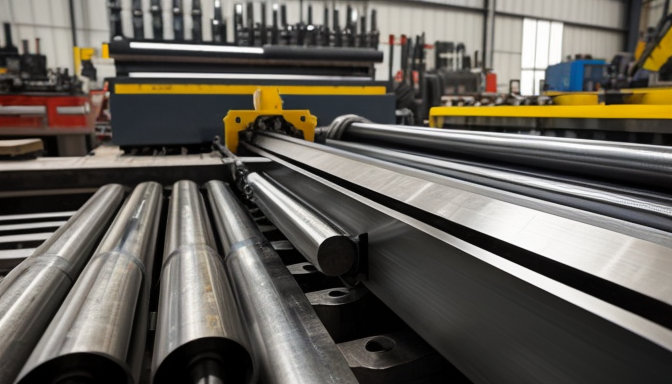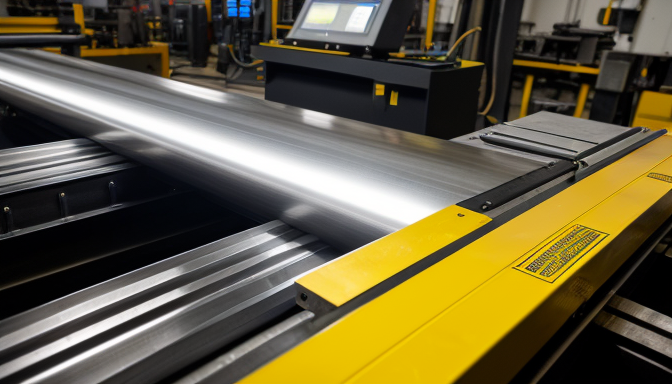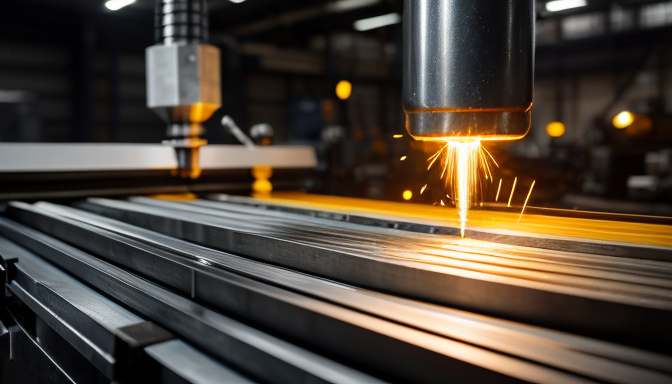Cylindrical steel sheet bending is an essential process in various industries, transforming flat sheets into curved forms. This technique is not just about bending metal; it’s about creating functional shapes that serve a purpose. Think of it like molding clay, but with steel. The art of bending steel sheets can lead to incredible designs, from pipes to tanks and everything in between.
But why should you care about cylindrical steel sheet bending? Well, whether you’re a professional in manufacturing or just someone interested in metalwork, understanding this process can be a game changer. It’s not just about aesthetics; it’s about functionality, durability, and cost-effectiveness. The right bend can make or break a project, quite literally!
In this article, we’ll dive into the nitty-gritty of cylindrical steel sheet bending. We’ll explore key areas such as costs, weight limits, techniques, sizes, and applications. Each of these elements plays a significant role in how bending is approached and executed. So, whether you’re planning a project or simply curious about the process, you’re in the right place!
So, what can you expect? We’ll break down the costs associated with bending, considering materials and labor. We’ll also discuss weight limits, which are crucial for understanding what can be bent and how. Techniques will be explored, showcasing the different methods used to achieve precise bends. Sizes matter too; the dimensions of the steel sheets dictate the bending processes available. Finally, we’ll look at the applications of this bending technique across various industries, highlighting its importance in real-world scenarios.
Get ready to discover the fascinating world of cylindrical steel sheet bending. It’s not just about bending metal; it’s about understanding how to shape the future, one curve at a time!
Cylindrical Steel Sheet Bending Cost
Understanding the cost factors involved in cylindrical steel sheet bending is crucial for budgeting projects. When you dive into this world, you’ll quickly realize that several elements come into play. First off, there’s the cost of materials. The type of steel you choose can significantly impact your budget. For instance, stainless steel tends to be pricier than mild steel. But why does that matter? Well, if you’re working on a project where durability is key, investing in higher-quality materials might save you headaches down the road.
Next up is labor. Skilled workers are essential for precise bending operations. Their expertise comes at a cost. If you’re hiring professionals, factor in their hourly rates. But remember, quality work often leads to fewer mistakes, which can save you money in the long run. It’s like hiring a good mechanic; you might pay a bit more upfront, but they’ll get the job done right.
Now, let’s talk about equipment. The machinery used for bending can also affect costs. Are you renting or buying? Each option has its pros and cons. Renting might be cheaper for short-term projects, but purchasing equipment could be more economical for long-term use. Consider this table for a quick overview:
| Cost Factor | Details |
|---|---|
| Materials | Type of steel affects pricing. |
| Labor | Skilled workers command higher wages. |
| Equipment | Renting vs. buying can change costs. |
In addition to these factors, it’s important to consider the scale of your project. Larger projects often benefit from bulk pricing on materials. Additionally, the complexity of the bends required might influence the overall cost. If you’re looking at intricate designs, be prepared to spend a bit more on both labor and time. After all, time is money.
Lastly, don’t forget about overhead costs. These can include things like utilities, maintenance, and even shipping fees for materials. All these elements contribute to the final tally of your bending project. So, before you dive in, take a moment to assess your budget. A well-planned project can lead to savings and smoother operations.

Cylindrical Steel Sheet Bending Weight Limits
When it comes to cylindrical steel sheet bending, understanding the weight limits is absolutely essential. Why? Because these limits dictate what can and cannot be bent effectively. If you exceed these limits, you risk damaging both the material and the equipment. Imagine trying to bend a thick book with a flimsy paperclip. It just won’t work. Similarly, bending steel sheets has its own set of rules.
Several factors influence these weight limits, including the thickness of the steel, the type of bending technique used, and the machinery involved. For instance, a thicker sheet will naturally weigh more and may require a more robust machine to handle the bending process. Additionally, the bending method—whether it’s air bending, bottom bending, or roll bending—will also affect how much weight can be safely manipulated.
To give you a clearer picture, let’s break down some common weight limits based on thickness:
| Thickness (mm) | Weight Limit (kg/m²) | Bending Method |
|---|---|---|
| 1.0 | 50 | Air Bending |
| 2.0 | 100 | Bottom Bending |
| 3.0 | 150 | Roll Bending |
As you can see from the table, the weight limits increase with the thickness of the sheet. However, it’s not just about thickness; the material composition also matters. For example, stainless steel has different properties compared to mild steel, which can affect its flexibility and weight limits during bending.
Moreover, environmental factors like temperature can also play a role. Cold steel is more brittle and can crack under stress, while warm steel is more pliable. Thus, knowing these variables can help you plan your bending operations more effectively.
In conclusion, understanding the weight limits in cylindrical steel sheet bending is crucial for any project. It can save you time, money, and headaches down the line. Always consider the thickness, material, and bending method before starting your bending tasks. After all, bending steel is not just about force; it’s about finesse.
Cylindrical Steel Sheet Bending Techniques
Bending cylindrical steel sheets is an art and a science. It’s not just about making a curve; it’s about precision and technique. Different methods are employed to achieve the desired shape, and each technique has its own unique advantages. So, what are these techniques, and how do they work?
One of the most common methods is roll bending. Imagine a giant rolling pin that shapes the steel into a curve. This technique uses three rollers to gradually bend the sheet into a cylinder. It’s efficient for large sheets and can handle various thicknesses. However, it does require careful calculations to ensure the final product meets the exact specifications.
Another popular method is press brake bending. This technique involves using a machine that presses the steel sheet between a punch and a die. Think of it like squeezing a piece of dough into a specific shape. This method is great for smaller, more precise bends, and it can produce sharp angles that roll bending might struggle with. However, it’s important to note that press brake bending might not be suitable for very thick sheets.
Then there’s hydraulic bending. This method uses hydraulic pressure to bend the steel, allowing for more control. It’s particularly useful for complex shapes. You can achieve a variety of angles and curves, making it a favorite in industries where customization is key. The downside? It can be more costly due to the machinery involved.
So, how do you decide which technique to use? Here are some factors to consider:
- Thickness of the steel sheet: Thicker sheets may require more powerful machines.
- Desired angle and radius: Some methods are better suited for specific angles.
- Production volume: Are you working on a one-off project or mass production?
Each of these techniques has its place in the world of cylindrical steel sheet bending. For instance, in the construction industry, roll bending is often favored for its efficiency in creating large structures, while press brake bending is preferred for smaller components that require precision. Understanding these techniques not only helps in selecting the right method but also ensures that the final product meets quality standards.
In conclusion, whether you’re a professional in the field or just an enthusiast, knowing these bending techniques can enhance your approach to projects. It’s all about choosing the right method for your specific needs. With the right technique, you can achieve impressive results that stand the test of time.

Cylindrical Steel Sheet Bending Sizes
Cylindrical steel sheets come in various sizes, and understanding these dimensions is crucial for effective bending operations. The size of the steel sheet not only dictates the bending techniques used but also influences the choice of equipment and the overall feasibility of the project. When we talk about sizes, we typically refer to both the thickness and the diameter of the cylindrical sheets. Thicker sheets can be more challenging to bend, while the diameter affects how tight of a curve can be achieved.
Commonly, cylindrical steel sheets are available in standard sizes. For instance, you might find sheets that are:
- Thickness: Ranging from 1 mm to 20 mm
- Diameter: Typically between 100 mm to 3000 mm
These dimensions are not just numbers; they have real-world implications. A thicker sheet means more strength but also requires more power to bend. On the other hand, a larger diameter can allow for more intricate designs but may also demand specialized machinery.
When choosing the size of your cylindrical steel sheet, consider the application it will serve. For example, in the construction industry, larger diameters are often necessary for structural components, while smaller diameters might be sufficient for decorative elements. Each application has its own set of requirements that dictate the ideal size.
Moreover, the bending process varies significantly with size. For instance, smaller sheets can be bent using manual methods, while larger sheets often require hydraulic or CNC bending machines. This difference can impact not just the cost but also the time it takes to complete a project.
To summarize, understanding the sizes of cylindrical steel sheets is essential for anyone involved in bending operations. It influences not just the bending techniques and equipment used but also the overall success of the project. Keep in mind that selecting the right size can make all the difference between a smooth operation and a challenging one.
Cylindrical Steel Sheet Bending Applications
Cylindrical steel sheet bending is a fascinating process with a wide range of applications across various industries. From construction to manufacturing, the ability to bend steel sheets into cylindrical shapes opens up a world of possibilities. Imagine the sturdy pipes that transport water or the sleek tanks that store chemicals; all of these rely on precise bending techniques. The versatility of this process makes it essential in many fields. But what exactly are these applications?
In the construction industry, cylindrical steel sheets are often used to create structural components. Think about the beams that support buildings or the cylindrical columns that provide stability. These elements need to be strong yet flexible enough to withstand various stresses. Bending steel sheets into the right shapes ensures they fit perfectly into the overall design.
Another significant application is in the manufacturing of pressure vessels. These vessels are used to hold gases or liquids at high pressures. Bending steel sheets into cylindrical forms allows for the creation of robust containers that can handle extreme conditions. It’s crucial that these vessels are manufactured with precision to ensure safety and efficiency.
Additionally, the automotive industry benefits greatly from cylindrical steel sheet bending. Car frames and exhaust systems often require bent steel components. By utilizing advanced bending techniques, manufacturers can create lightweight yet durable parts that enhance vehicle performance. This not only improves fuel efficiency but also contributes to overall vehicle safety.
Moreover, the energy sector uses cylindrical steel sheets in pipelines and storage tanks. These applications are vital for transporting oil, gas, and other resources. The bending process must ensure that the pipes are seamless and can withstand the pressure of the materials they carry. Any flaw in the bending could lead to catastrophic failures.
To summarize, the applications of cylindrical steel sheet bending are extensive and critical to many industries, including:
- Construction: Structural components like beams and columns.
- Manufacturing: Pressure vessels for gases and liquids.
- Automotive: Car frames and exhaust systems.
- Energy: Pipelines and storage tanks for oil and gas.
In conclusion, cylindrical steel sheet bending is not just a technical process; it’s a cornerstone of modern industry. Whether you are driving a car, living in a building, or using energy resources, chances are you are benefiting from this incredible technique. Understanding its applications can help professionals and enthusiasts appreciate the complexity and importance of this craft.
Frequently Asked Questions
- What factors influence the cost of cylindrical steel sheet bending?
The cost of cylindrical steel sheet bending is influenced by several factors, including the type of material used, labor costs, and the equipment required for the bending process. Additionally, the complexity of the design and the volume of sheets being bent can also affect pricing. It’s essential to get a detailed quote from your supplier to understand all potential costs involved.
- What are the weight limits for bending cylindrical steel sheets?
Weight limits for bending operations depend on the thickness and type of steel sheet, as well as the specific bending technique used. Generally, thicker sheets will have lower weight limits due to the increased force required for bending. It’s crucial to consult with your bending service provider to determine the appropriate weight limits for your specific project.
- What techniques are commonly used in cylindrical steel sheet bending?
Several techniques can be employed for bending cylindrical steel sheets, including roll bending, press braking, and rotary bending. Each method has its own advantages and is suited for different applications. For instance, roll bending is ideal for creating large-radius bends, while press braking is often used for more precise angles.
- What sizes of cylindrical steel sheets are typically available?
Cylindrical steel sheets come in various standard sizes, which can affect the bending process. Common sizes range from small sheets for lightweight applications to larger sheets used in heavy industrial settings. It’s important to select the right size for your project to ensure optimal bending results.
- What are the main applications of cylindrical steel sheet bending?
Cylindrical steel sheet bending is widely used in various industries, including construction, automotive, and manufacturing. Common applications include creating pipes, tanks, and structural components. Its versatility makes it a crucial process in producing parts that require specific shapes and tolerances.
